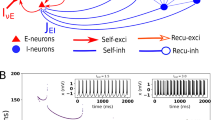Abstract
We elucidate how coupling delays and noise impact phase and mutual information relationships between two stochastic brain rhythms. This impact depends on the dynamical regime of each PING-based rhythm, as well as on network heterogeneity and coupling asymmetry. The number of peaks at positive and negative time lags in the delayed mutual information between the two bi-directionally communicating rhythms defines our measure of flexibility of information sharing and reflects the number of ways in which the two networks can alternately lead one another. We identify two distinct mechanisms for the appearance of qualitatively similar flexible information sharing. The flexibility in the quasi-cycle regime arises from the coupling delay-induced bimodality of the phase difference distribution, and the related bimodal mutual information. It persists in the presence of asymmetric coupling and heterogeneity but is limited to two routes of information sharing. The second mechanism in noisy limit cycle regime is not induced by the delay. However, delay-coupling and heterogeneity enable communication routes at multiple time lags. Noise disrupts the shared compromise frequency, allowing the expression of individual network frequencies which leads to a slow beating pattern. Simulations of an envelope-phase description for delay-coupled quasi-cycles yield qualitatively similar properties as for the full system. Near the bifurcation from in-phase to out-of-phase behaviour, a single preferred phase difference can coexist with two information sharing routes; further, the phase laggard can be the mutual information leader, or vice versa. Overall, the coupling delay endows a two-rhythm system with an array of lead-lag relationships and mutual information resonances that exist in spite of the noise and across the Hopf bifurcation. These beg to be mapped out experimentally with the help of our predictions.






Similar content being viewed by others
References
Acebrón JA, Bonilla LL, Vicente CJP, Ritort F, Spigler R (2005) The Kuramoto model: a simple paradigm for synchronization phenomena. Rev Mod Phys 77(1):137
Battaglia D, Brunel N, Hansel D (2007) Temporal decorrelation of collective oscillations in neural networks with local inhibition and long-range excitation. Phys Rev Lett 99(23):238106
Battaglia D, Witt A, Wolf F, Geisel T (2012) Dynamic effective connectivity of inter-areal brain circuits. PLoS Comput Biol 8(3):e1002438
Byrne Á, O’Dea RD, Forrester M, Ross J, Coombes S (2020) Next-generation neural mass and field modeling. J Neurophysiol 123(2):726–742
Deschle N, Daffertshofer A, Battaglia D, Martens EA (2019) Directed flow of information in chimera states. Front Appl Math Stat 5:28
Dumont G, Gutkin B (2019) Macroscopic phase resetting-curves determine oscillatory coherence and signal transfer in inter-coupled neural circuits. PLoS Comput Biol 15(5):e1007019
Dumont G, Northoff G, Longtin A (2016) A stochastic model of input effectiveness during irregular gamma rhythms. J Comput Neurosci 40(1):85–101
Fries P (2005) A mechanism for cognitive dynamics: neuronal communication through neuronal coherence. Trends Cogn Sci 9(10):474–480
Fries P (2015) Rhythms for cognition: communication through coherence. Neuron 88(1):220–235
Greenwood PE, McDonnell MD, Ward LM (2014) Dynamics of gamma bursts in local field potentials. Neural Comput 27(1):74–103
Kirst C, Timme M, Battaglia D (2016) Dynamic information routing in complex networks. Nat Commun 7(1):1–9
Lindner B, Garcıa-Ojalvo J, Neiman A, Schimansky-Geier L (2004) Effects of noise in excitable systems. Phys Rep 392(6):321–424
Lowet E, Roberts MJ, Peter A, Gips B, De Weerd P (2017) A quantitative theory of gamma synchronization in macaque v1. Elife 6:e26642
Palmigiano A, Geisel T, Wolf F, Battaglia D (2017) Flexible information routing by transient synchrony. Nat Neurosci 20(7):1014
Pikovsky A, Kurths J, Rosenblum M, Kurths J (2003) Synchronization: a universal concept in nonlinear sciences, vol 12. Cambridge University Press, Cambridge
Powanwe AS, Longtin A (2019) Determinants of brain rhythm burst statistics. Sci Rep 9(1):1–23
Powanwe AS, Longtin A (2020) Phase dynamics of delay-coupled quasi-cycles with application to brain rhythms. Phys Rev Res 2(4):043067
Powanwe AS, Longtin A (2021) Amplitude-phase description of stochastic neural oscillators across the Hopf bifurcation. Phys Rev Res 3(3):033040
Powanwe AS, Longtin A (2021) Mechanisms of flexible information sharing through noisy oscillations. Biology 10(8):764
Rodrigues FA, Peron TKD, Ji P, Kurths J (2016) The Kuramoto model in complex networks. Phys Rep 610:1–98
Schreiber T (2000) Measuring information transfer. Phys Rev Lett 85(2):461
Ter Wal M, Tiesinga PH (2017) Phase difference between model cortical areas determines level of information transfer. Front Comput Neurosci 11:6
Wallace E, Benayoun M, Van Drongelen W, Cowan JD (2011) Emergent oscillations in networks of stochastic spiking neurons. Plos One 6(5):e14804
Winfree AT (1967) Biological rhythms and the behavior of populations of coupled oscillators. J Theor Biol 16(1):15–42
Xing D, Shen Y, Burns S, Yeh C-I, Shapley R, Li W (2012) Stochastic generation of gamma-band activity in primary visual cortex of awake and anesthetized monkeys. J Neurosci 32(40):13873–13880a
Acknowledgements
This research was supported by the Natural Sciences and Engineering Research Council of Canada through grant #RGPIN/06204-2014.
Author information
Authors and Affiliations
Corresponding author
Ethics declarations
Conflict of interest
The authors declare no conflict of interest.
Additional information
Communicated by Peter Thomas.
Publisher's Note
Springer Nature remains neutral with regard to jurisdictional claims in published maps and institutional affiliations.
Rights and permissions
About this article
Cite this article
Powanwe, A.S., Longtin, A. Mutual information resonances in delay-coupled limit cycle and quasi-cycle brain rhythms. Biol Cybern 116, 129–146 (2022). https://doi.org/10.1007/s00422-022-00932-x
Published:
Issue Date:
DOI: https://doi.org/10.1007/s00422-022-00932-x




